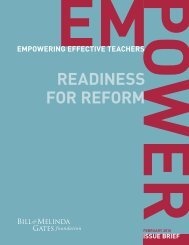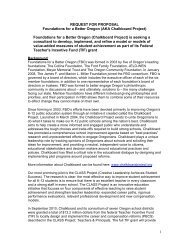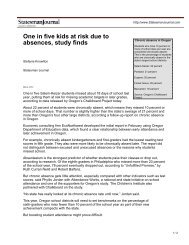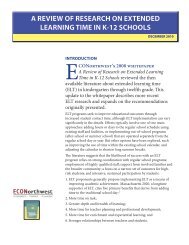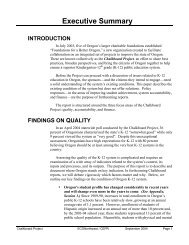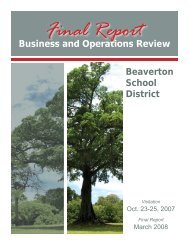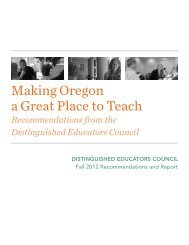Tapping the Potential - Alliance for Excellent Education
Tapping the Potential - Alliance for Excellent Education
Tapping the Potential - Alliance for Excellent Education
Create successful ePaper yourself
Turn your PDF publications into a flip-book with our unique Google optimized e-Paper software.
TA P P I N G T H E P O T E N T I A L : R E TA I N I N G A N D D E V E L O P I N G H I G H - Q U A L I T Y N E W T E A C H E R Steachers’ education, certification, teaching assignments, professional development, collaboration,and supportive work environment. In addition, comparisons by instructionallevel and poverty level of <strong>the</strong> school provide in<strong>for</strong>mation about <strong>the</strong> distribution ofteacher quality. This in<strong>for</strong>mation provides a context <strong>for</strong> understanding teachers’reports of preparedness to meet <strong>the</strong> challenges <strong>the</strong>y face in <strong>the</strong>ir classrooms.National Center <strong>for</strong> <strong>Education</strong> Statistics. Progress Through <strong>the</strong> Teacher Pipeline:1992–93 College Graduates and Elementary/Secondary School Teaching as of 1997.Washington, D.C.: U.S. Department of <strong>Education</strong>, 2000.This report is <strong>the</strong> second in a series that follows 1992–93 college graduates’ progressthrough <strong>the</strong> teacher pipeline using data from <strong>the</strong> Second Follow-up of <strong>the</strong>Baccalaureate and Beyond Longitudinal Study (B&B:93/97). This report focuses on <strong>the</strong>academic characteristics and preparation <strong>for</strong> teaching of those who took various stepstoward teaching and is organized by a conceptual “teacher pipeline” that represents ateacher’s career. The pipeline includes preparatory activities—considering teaching, studentteaching as an undergraduate, becoming certified to teach, and applying <strong>for</strong>teaching jobs—as well as teaching experiences and plans <strong>for</strong> teaching in <strong>the</strong> future.National Center <strong>for</strong> <strong>Education</strong> Statistics. Attrition of New Teachers Among RecentCollege Graduates: Comparing Occupational Stability Among 1992–93 CollegeGraduates Who Taught and Those Who Worked in O<strong>the</strong>r Occupations. Washington,D.C.: U.S. Department of <strong>Education</strong>, 2001.This research examines <strong>the</strong> occupational stability of bachelor’s degree recipientsduring <strong>the</strong> first four years after receiving <strong>the</strong>ir degrees. The analyses address <strong>the</strong> question,were graduates who were teaching in 1994 more or less likely than those in o<strong>the</strong>roccupations to leave <strong>the</strong> work<strong>for</strong>ce or work in a different occupation in 1997? Thisreport aptly details <strong>the</strong> teacher attrition problem.National Commission on Teaching and America’s Future. No Dream Denied: APledge to America’s Children. Washington, D.C.: National Commission on Teachingand America’s Future, 2003.Building on <strong>the</strong>ir 1996 report What Matters Most, NCTAF examines <strong>the</strong> quality ofAmerica’s teaching profession through <strong>the</strong> lens of recruiting and retaining excellentteachers <strong>for</strong> every child. To ensure that “highly qualified” beginning teachers meet <strong>the</strong>high standards anticipated by <strong>the</strong> No Child Left Behind Act, <strong>the</strong> commission makesrecommendations about teacher preparation, <strong>the</strong> characteristics of schools to supportteacher learning, and hiring and support practices, including induction programs, toprovide benchmarks <strong>for</strong> overall teacher professional development.Public <strong>Education</strong> Network. The Voice of <strong>the</strong> New Teacher. Washington, D.C.: Public<strong>Education</strong> Network, 2003.This report contains research into <strong>the</strong> perspectives of new teachers on <strong>the</strong> quality ofteacher preparation, <strong>the</strong> first years of teaching, and supports provided by districts andschools during early years in <strong>the</strong> profession. Conducted in four communities—Chattanooga, Tennessee; New York, New York; Seattle, Washington; and Washington,D.C.—<strong>the</strong> research surveyed more than 200 teachers. New teachers made several rec-61



